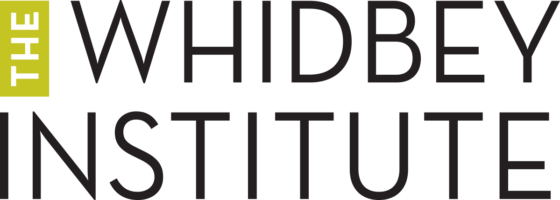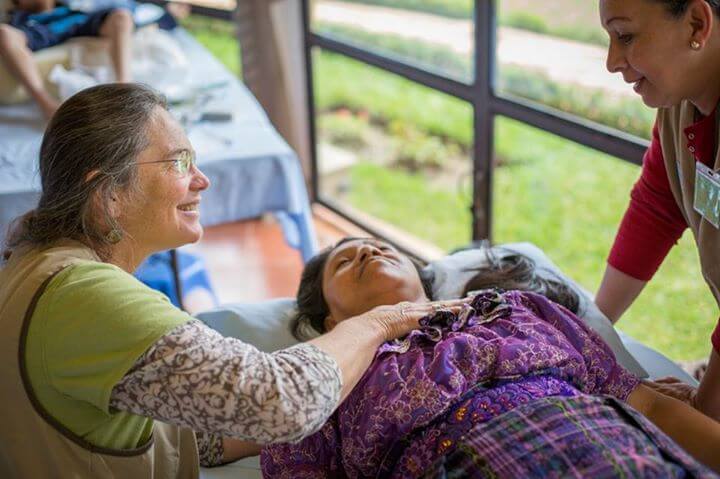This December, the Whidbey Institute will welcome a five-day intensive on Mindful Awareness in Body-oriented Therapy (MABT), hosted by Cynthia Price, Elizabeth Chaison, and Carla Wiechman of the Center for Mindful Body Awareness (CMBA). I connected with Cynthia, CMBA Director, about the program last week. Here’s that conversation. —Marnie Jackson
Marnie: Who is your audience for this program?
Cynthia: Our audience is primarily therapists who want more strategies to promote clients’ capacity to attend to their somatic experience. We typically have both bodyworkers who are interested in working more in the emotional realm and mental health therapists who are interested in working more in the somatic realm. We often have people come who are dually trained, both in mental health and in somatically-based work, and are looking for a structured approach that helps them bring these realms together. MABT is focused on developing interoceptive awareness, or awareness of internal body sensory experience—physical and emotional. Being familiar or experienced with mindfulness and the development of internal presence is important for learning MABT, as it is a mindfulness-based approach.
What style of teaching can participants can expect?
We’ll spend the majority of the program time experientially learning the different components of the MABT approach, practicing in dyads. The program also includes didactic elements, Q & A, and discussion relative to what comes up during experiential practice.
There will be three instructors at this course as it is critical to provide a lot of individual support in the learning process. Carla and Elizabeth have been teaching with me for many years, and have also worked with me on multiple research studies. Together we’re very experienced in delivering this approach with people from all walks of life, including people with serious and co-occurring mental and physical health issues.
What’s the ultimate purpose of this intensive, beyond providing education to the practitioners who participate?
This is ultimately in service to clients. Through MABT, we teach people to bring their awareness into their bodies, which some people can do very easily but which many cannot. We help the therapist develop the ability to promote presence and mindful attention to the body in their clients.
For the client, whether they’re in therapy with a body worker, a mental health provider, or a physical therapist, we hope that MABT skills will give them a new set of tools in their toolbox—tools that let them become more aware of how they feel on the inside.
For the client, whether they’re in therapy with a body worker, a mental health provider, or a physical therapist, we hope that MABT skills will give them a new set of tools in their toolbox—tools that let them become more aware of how they feel on the inside.
Sensory awareness, emotional awareness, and an understanding of the link between emotions and other physical sensations can be highly useful for people dealing with chronic discomfort or pain. They can also be deeply supportive of symptom management for clients dealing with chronic health issues.
In my research, we find that people in recovery from sexual and physical abuse and substance use are often very disconnected from their bodies. MABT is highly supportive for their emotion regulation, and for helping people reduce their risk for substance use relapse. These skills can also reduce the likelihood of someone being triggered around trauma histories. This approach can change the way people understand their bodies and develop new ways of relating to themselves and to others, as they become more aware and embodied.
Ideally there’s a next step outcome, besides the obvious training of practitioners to facilitate clients’ learning these skills for enhanced awareness and better self-care. This next step is to move this kind of work more into the mainstream. I’m interested in ways that this work can be integrated into more conventional health services and the services provided on a larger institutional level. As an example, MABT research in service to people with substance use disorders has been implemented within conventional community programs, primarily serving low-income and underserved populations. We are currently implementing a NIH-funded clinical trial of MABT in primary care settings for individuals receiving medication-assisted treatment for opioid use disorder. These studies indicate the feasibility and benefits of MABT as an integral component of care.
MABT can be helpful for preventive care—promoting stress reduction, self-care, and symptom management—as well as for treatment of multiple physical and mental health conditions. At this point, this type of approach is only accessible for people with more resources who can afford to see a private practitioner. We hope to develop programs that can be instituted and integrated into care so that they are accessible for anyone.
Why did you choose the Whidbey Institute as a home for this intensive?
There is tremendous power in bringing attention into the body and staying with sensation; clients develop a sense of freedom and empowerment. The enhanced ability to stay in brings a sense of peace.
This will be our second Intensive at the Whidbey Institute. We’re coming back because of the supportive environment that the Whidbey Institute provides —the beautiful space and wonderful food. We appreciate how easy it is to be there. The context supports intense work as well as replenishment through relaxed time together over meals, during walks on the land, and in the quiet of the woods. We also appreciate the graceful, experienced staff who hold space for these experiences.
Is there anything else you’d like our readers to know about?
I’d like to share some comments from my co-facilitator, Elizabeth. She said, “through learning MABT, I gained new skills for guiding clients into their bodies and staying with sensation in a rich and in-depth way—and how to meld a somatic focus with emotionally-based work. MABT supports clients in forming a connection with their inner world. Through this process, clients develop tools for self-care based on their own journey of self-discovery. . . . Clients learn mindfulness skills and develop body awareness practices that they can incorporate into their daily lives and that are specific to their individual needs. The hands-on approach of MABT helps to deepen clients’ physical and emotional relationship to self, facilitating a safe way to explore. There is tremendous power in bringing attention into the body and staying with sensation; clients develop a sense of freedom and empowerment. The enhanced ability to stay in brings a sense of peace.”

